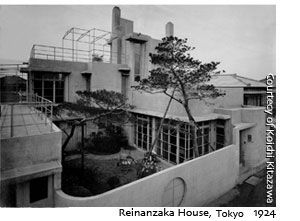Raymond's first major designs were Wrightian and in reinforced concrete,
but he soon began developing an indigenous modernism — as evidenced by his groundbreaking 1924 Reinanzaka
Villa — and earning his own reputation. From the early 1920s onward, the Raymond office had a constant
influx of ideas from Europe. Kunio Maekawa, who had worked for Le Corbusier in Paris, joined the office
in 1930. Later, he would train Kenzo Tange, Japan's greatest 20th century architect. Junzo Yoshimura
and George Nakashima also worked with Raymond, both in Japan and in New Hope, PA, where the Raymonds
lived during WWII.
Raymond built Tokyo's first permanent postwar structure, the innovative, ultramodern Reader's Digest
Building. He continued to experiment with materials and to sample an array of styles, prompting one critic
to dub him a "violent evolutionary." But Raymond has been credited with the fusion of Japanese
traditional architecture and contemporary design, fueling Japan's great mid-century building
boom and maintaining the nation's continued stature in the global architectural arena.
(KS)


